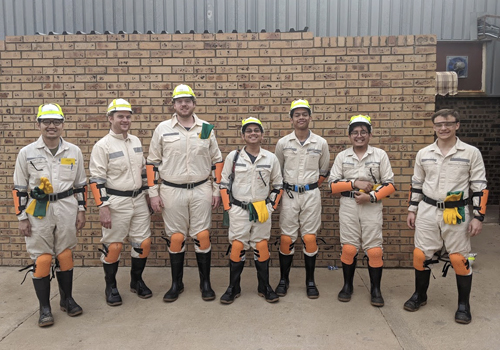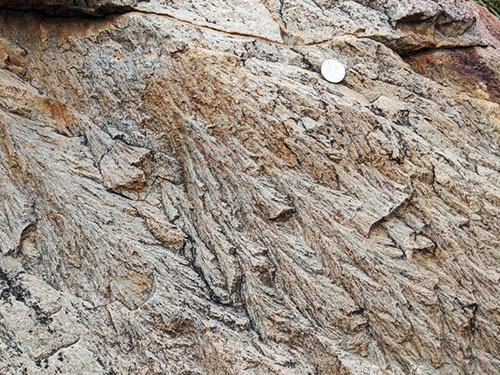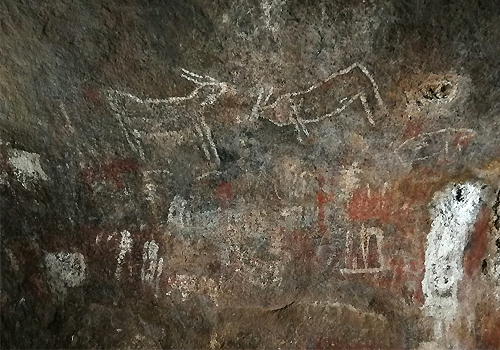“In geology,” says Dan Gregory, “the person who wins is the person who sees the most rocks.”
And one of the ways geology students get to see lots of rocks is to get out of the classroom and into the field.
That’s what a group of undergraduate students did last winter — before pandemic travel restriction were in place — when they visited South Africa with Gregory and Xu Chu, both assistant professors in the Department of Earth Sciences in the Faculty of Arts & Science.
The trip combined two earth science International/Indigenous Course Modules (ICM) that included Chu’s mostly second-year students and Gregory’s mostly fourth-year group.

Not only did the ICMs offer students an opportunity to see lots of rocks, they did it in one of the most geologically fascinating locations on the planet.
“For a geologist, South Africa is one of the best places to visit,” says Gregory. “It has the world's largest platinum, manganese and gold deposits, as well as diamond mines.”
Esther Bushuev is a member of Woodsworth College, majoring in physical and environmental geography with a double minor in geoscience and geographic information systems.
“Because we were in the field,” she says, “we were able to make connections between what we observed on the trip and what we learned in lectures and labs.”
“These trips are important,” adds Chu. “In their future careers, students will have to work in the field. They’ll need to understand the relationship between a rock and its geological history.
“Also, if a student isn’t sure they want to pursue a career in geology,” he says, “a trip like this shows them how fascinating the discipline is. Plus, they get the opportunity to learn about future career options by talking to actual field engineers and geologists working in the mines.”
Dean Hiler is a member of Woodsworth College majoring in earth and environmental systems and minoring in geographic information systems and the history and philosophy of science and technology.
Hiler says the trip was “a chance to see evidence of Earth’s history first-hand and to see another country, continent and culture. It was a once-in-a-lifetime opportunity I couldn’t turn down.”

The group started their eight-day trek in Johannesburg and drove some 2500 kilometres, crisscrossing the country in two vans, visiting nearly a dozen sites.
South Africa has hundreds of mines — many more than Canada — and the Witwatersrand gold field is home to some of the deepest in the world. The group visited the Moab Khotsong gold mine and descended more than three kilometres below the surface. They also visited the Kalahari manganese mine, a vast open pit operation in the middle of the Kalahari Desert.
The itinerary included the Vredefort impact crater, the largest impact crater on Earth — larger even than the Sudbury basin.
“Imagine a crater 200 kilometres wide,” says Hiler, “created by the impact of an asteroid 10 to 15 kilometres wide. The impact, two billion years ago, was unimaginably large and created shatter cones in the nearby rocks.
“Shatter cones are rocks that look like lightning shooting out away from the direction of the impact. I found one along the road near an exposed outcrop and I’ll cherish it for the rest of my life.”
While the ICM focused on science, the students also learned how the country’s geology was closely linked with its history and culture — including apartheid — and how its mineral wealth provided legitimacy for racial exclusivism, segregation and social injustice.

The lesson was not lost on Hiler. “The geology of South Africa is billions of years old and rich in the resources needed in the modern age,” he says. “In the past, colonialists got the lion’s share of mining profits, which contributed to the colossal social inequalities we still see today.
“Present-day South Africa must find a balance between preserving safe jobs, keeping extraction costs globally competitive and ensuring the profits go toward elevating those who have been excluded.”
The students also visited significant anthropological sites like the Wonderwerk cave, which U of T archaeologists showed was occupied by human ancestors two million years ago. The cave contains evidence of the earliest use of controlled fire — from a million years ago — and continues to be studied by U of T anthropologists.
In addition to lots of rocks, the trip also provided an opportunity to see what day-to-day life as a field geologist would be like. In a heavy rainstorm, one of the vans hit a pothole and blew a tire, forcing the group to change the tire in the downpour.
“It’s good training,” says Chu with a grin. “If you are a geologist working in the field, you’ll have an experience like this sooner or later.”

